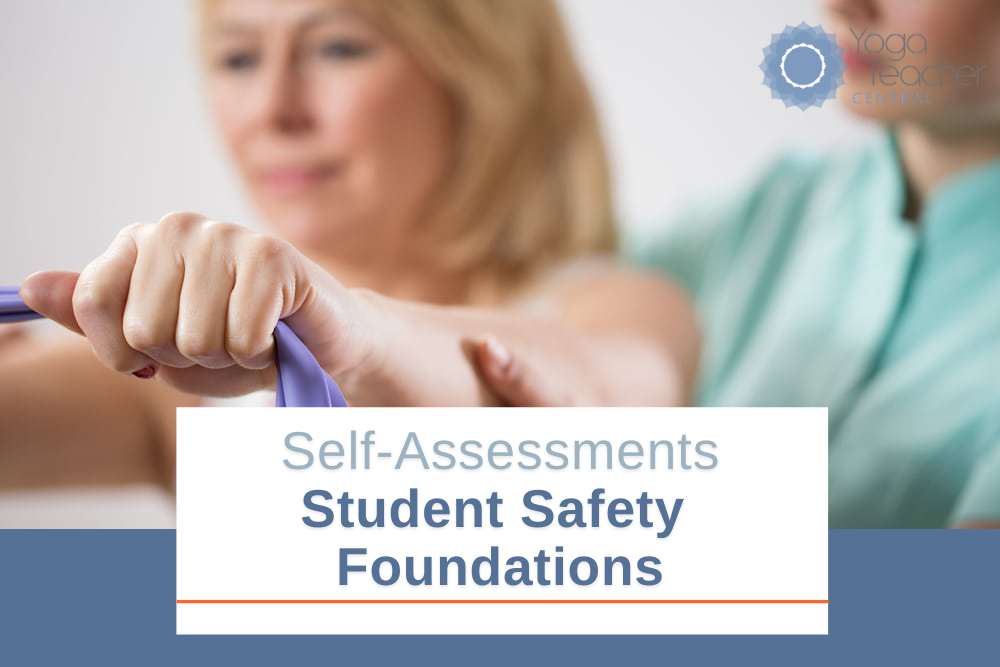
Introduction
Quickly assess your knowledge of Student Safety Foundations, and identify gaps in your education. See below for assessments on these subjects:
- Injuries & Conditions in Yoga
- About Sensation & Pain
- About Contraindications & Alternatives
- When to Refer Out
- Contraindications Index
Purpose
Offer a series of free quizzes for yoga teachers to:
- Provide an effective way to assess knowledge of each of the Teaching Knowledge Standards.
- Make it easy to self-assess privately, on your own time.
- Help teachers who identify educational gaps to bolster their knowledge with accessible and practical lessons.
More Self-Assessments
For more self-assessments, see the Standards & Self-Assessment Hub.
Injuries & Conditions in Yoga

Teaching Standard
Become knowledgeable in injury prevention and ways to accommodate students who have injuries and conditions.
Assessment
- According to a 13-year study of yoga-related injuries in the U.S. (published in 2017), the majority of injuries occurred in what category of students?
- In what different ways can we consider the topic of student injuries and conditions?
- What are five common causes of yoga injuries?
- How can teachers contribute to the prevention of injuries in yoga classes?
- To go beyond accommodation of a student’s condition is outside the scope of yoga teachers. Explain.
- What is required to safely accommodate students with injuries and conditions in class?
- How can teachers address some of the inherent challenges of teaching an individual practice in a group setting?
- What are some challenges and considerations related to learning about individual students in a group class?
Sensation & Pain

Teaching Standard
Gain an understanding of the complexity of pain and how to use this knowledge when teaching asana.
Assessment
- Define and discuss the meaning and implications of pain.
- How are acute and chronic pain different (aside from the length of time they’re experienced)?
- What is negativity bias and how does it impact the experience of pain?
- How might healthy sensation in asana be described?
- In addition to physical sensation, yoga practice may prompt memories or emotions. What is a consideration related to emotional release and healthy sensation?
- What is compression?
- What are some considerations related to compression in asana?
- What are signs of unhealthy sensation in yoga asana?
- For what potential reasons may a student be unable to examine her experience of sensation and/or to communicate it?
- What are some reasons that students may not value their personal experience or be skilled in evaluating sensation?
- What can influence pain perception?
About Contraindications & Alternatives

Teaching Standard
Learn the importance of knowing and utilizing contraindications and cautions, and understand how to wisely choose alternatives.
Assessment
- What are contraindications? How are they different from cautions?
- Using the condition of sacroiliac (SI) joint pain, give an example of a contraindicated pose and a pose that is advised to be practiced with caution.
- If you are aware of the contraindications for key conditions, is that enough to guide a student who has a particular condition?
- How might you go about choosing an alternative pose suggestion for a student who is experiencing a condition that makes a particular pose contraindicated?
- It’s practically impossible to remember contraindications for every possible condition a student may be experiencing. How, then, can you use knowledge of contraindications in class?
When to Refer Out

Teaching Standard
Know when it’s advisable to refer students out for diagnosis or individual assessment and how to be prepared to do so.
Assessment
- How can you lessen the likelihood that students will attend a class that is not a good fit for them?
- Provide sample content targeted to students with injuries to help them choose a proper class and to arrive prepared.
- Why is it important to differentiate between issues related to imbalance vs. “pathological processes?”
- Describe symptoms that may indicate a need to refer out for immediate medical care.
- Name specific conditions for which it is advisable to refer students to work individually with an expert before attending a group class.
- Why should students taking painkillers be referred to a qualified yoga therapist?
- Yoga teachers are not trained or licensed to diagnose conditions. Explain.
- Provide considerations for responding to students who are experiencing a condition outside your qualifications and experience.
- If a student has had surgery, is injured, or has a serious condition, what questions does she need to be able to answer in order to guide decisions about safely practicing yoga?
Next Steps

- To view more self-assessments, go to the Standards & Self-Assessment Hub.
- To bolster your knowledge and be recognized as a YTC teacher, enroll in the Yoga Teacher Central Study Program (details below).
- Members, view clear and concise lessons:

In a Nutshell
- The enrollment fee is $25 and is open to Yoga Teacher Central members, past members and non-members.
- Members receive current membership benefits plus additional benefits listed below.
- Enrollment in the Study Program qualifies you for lifetime YTC Teacher status.
Benefits
Enrolling in the Study Program gives you:
- A downloadable Knowledge Standards Lesson Guide to walk you through a structured study path toward certification.
- Selection of 5 downloadable lessons of your choice (from a library of nearly 500).
- Recognition as a YTC Teacher (for life; no expiration).
- Professional marketing kit for highlighting your YTC Teacher status on social media and your website.
- Excellent preparation for taking certification exams.
Members
- Your current membership gives you online access to not only thousands of pages of organized study and teaching knowledge, but also sequence breakdowns and teaching notes, theme plans, injury cheat-sheets, and so on.
- When you enroll in the Study Program, you get these additional benefits: a Knowledge Standards Lesson Guide, selection of 5 downloadable lessons of your choice, and a professional marketing kit for highlighting your YTC Teacher status on social media and your website.

See here for information about exams, badges and certification. Get links for each exam, and for a no-risk trial exam.
We think you’ll enjoy taking the exams. The questions are well-thought-out and the subject matter is quite engaging and significant for teachers. You’ll get an inspiring teaching after answering each question. At the end of the exam, you see a summary of wrong answers and the relevant teachings, giving you a personal study guide targeted to your needs.
This is an hour well-spent!








